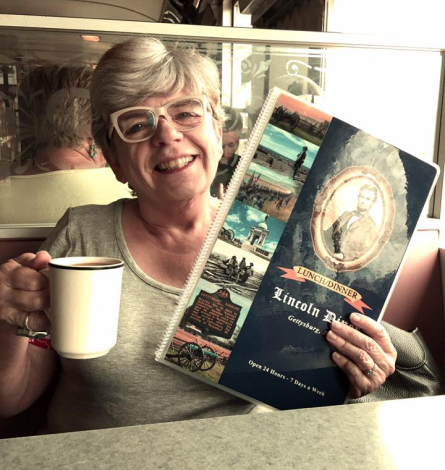A real highpoint for me, as an animal lover, was the behind-the-scenes tour I received, conducted by Cindy, who is in charge of protecting animals at the NFR and many other rodeos, and Dr. Doug Corey, a veterinarian with a lot of rodeo experience. The two of them work together to make sure horses, bulls, calves, etc. are treated well.
The broncs were all big and sturdy, and exuding health. The same could be said of the bulls–one of them took a dislike to me as I passed, lowered his head, and started pawing the ground. Cindy said brightly, “Just keep walking.” Sure, there was a fence, but that guy didn’t look like he’d have any trouble charging right through it. 🙂 Maybe he knew my daddy was a bull-rider, back in the day! Interestingly, the broncs are lead-trained, which makes sense because there has to be some way to get them in and out of the horse trailer.
There is a wide-spread myth that animals are cruelly prodded to make them buck. This is NOT TRUE. Rodeo stockmen breed horses that love to buck to OTHER horses that love to buck. I’ve been around livestock a lot in my life, and I can tell you, these animals are probably in better health than I am.
Calf-roping troubles a lot of people, so I’d like to say a word or two about that as well. I asked Dr. Corey if it hurt them. He reminded me that calves are sturdy–this is not like roping a dog or a human being. They get right up as soon as they’re been roped and tied, unharmed. Also, they are calves for a very short time, obviously. Precautions are taken, just the same. Dr. Corey told me that sometimes you’ll see a calf carried out of the arena on a stretcher, but this usually doesn’t mean they’re hurt. It’s meant to forestall any problems they might have later. For every calf roped in a rodeo, there are a thousand out there on the range–this is the only way to catch them. (They don’t come when you call them.:)) Why catch them in the first place? Because they need shots and a thousand other things done.
Rodeo grew, of course, out of the way cowboys worked on the range back in the old days. It’s a controversial subject, and there’s no way of getting around that. It is also a way of keeping history alive. To me, it is simply not the same as the barbaric dog and cock-fighting, in which animals are pitted against each other to fight to the death. That IS against the law, and it ought to be. The broncs and bulls and especially the roping and barrel-racing horses are athletes–you don’t need to watch them long to see how proud they are of their performance.
In any case, my intent is not to sway you one way or the other, but just to tell you how I see it.
One night during the rodeo, the announcer said the bull about to be released from the chute was a veteran, and this would be his last ride. He’d never been ridden to the buzzer (eight seconds), even one time, in all his career. In this case, the crowd was rooting for the bull–he had a perfect record, after all. (Bulls and broncs are alotted to riders by a lottery process. That’s why cowboys talk about the bull or bronc they “drew”.) Well, he held his own. Sent that cowboy sailing in about three seconds. Perfect record, 100 percent. There’s an inate respect between animal and rider. (Anybody who DOESN’T respect a ton of horns and hot blood is a damn fool.)
Suffice it to say, cowboys and cowgirls are the LAST people who would stand by and tolerate cruelty to an animal–or any other living creature. Over and over, I was struck by their kindness, their generosity, their honor, and their love of the sport.
To change the subject, it’s almost Christmas. I’m not ready, but then, I never am. Christmas comes anyhow, thank heavens. I’ll be out there shopping today, along with all the other last-minute Lewies.
Be blessed–I’ll be back on Monday, if not sooner. There’s one more thing I want to tell you about. 🙂




